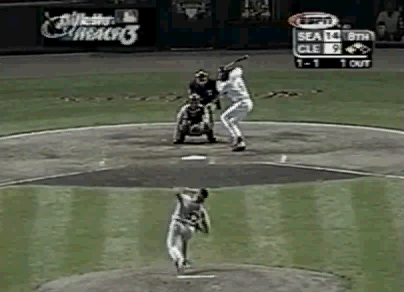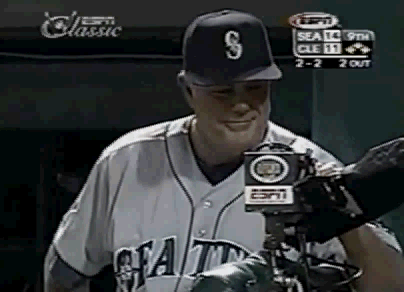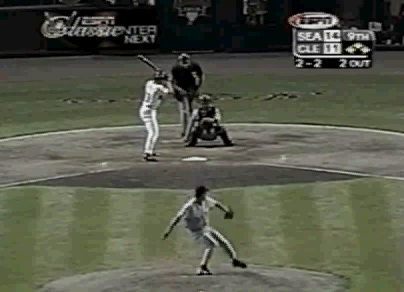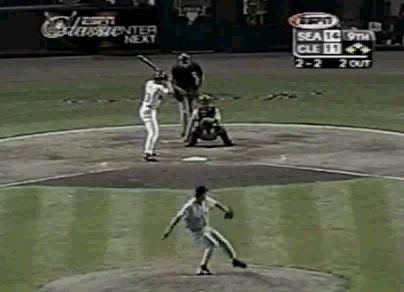The Ball that Allowed for the Rest of a Miracle
I don’t even remember what I was looking up on YouTube this morning, but there, in the sidebar, was this, and it just had to be clicked on.
It was, of course, a legendary baseball game, the rare regular-season game that interests more than just fans of the two teams involved. It wasn’t supposed to be anything special from the outset, but most people understand what happened that day — the unbeatable Seattle Mariners took a 14-2 lead over the Cleveland Indians into the bottom of the seventh, and the Cleveland Indians won.
As big a comeback as it was, there was no greater, lasting significance. The very next day, the Mariners beat the Indians. Both teams continued to play well down the stretch and they met in the ALDS, from which the Mariners emerged triumphant. The game wasn’t a turning point — it was just an isolated, random miracle, and that’s all it really has to be.
There are things I’d forgotten about the game, or just didn’t know. In part because it’s been more than a decade, in part because, while the game was on ESPN, I turned the TV off in the seventh to play catch with my brother. You can imagine my shock in returning to find the game in extra innings. A lot of people remember that the teams had gone to their benches. Once it proceeded to what seemed like garbage time, everyone got a chance to play. I had no recollection of this happening in the bottom of the eighth:
That’s Kenny Lofton getting tagged out at home with one down in a five-run game. What you don’t see is that Lofton hesitated before breaking for the plate. We know now how the game ended, but at the time, this was a terrible mistake. There would’ve been very little benefit had Lofton been able to score. His getting tagged out lowered the Indians’ win expectancy from about 6% to about 1%. The break-even rate on the play was about 99% — that is, for Lofton to go, he would’ve had to be 99% sure he’d make it safely. Maybe he could’ve made it if he didn’t hesitate. This was just a player getting over-excited, and as part of the Mariners’ late-inning collapse, they were given a very fortunate break. They still gave the game away.
Moving on, this is something you don’t see very often:
It’s not like anything comical had happened. An extremely stressful situation was brewing. In one dugout, Lou Piniella was smiling. In the other dugout, Charlie Manuel was smiling. It makes sense why Manuel might’ve been having a good time — his team had improbably made a game of the un-make-a-game-of-able. But in times of stress, you don’t expect two managers to be smiling at once. One manager ordinarily cancels the other manager out. I suppose one can be only so anxious when you’re sitting on a record of 80-30 and the next-closest team in the division is 20 games back.
Now we’re going to settle on a ninth-inning showdown between Kazuhiro Sasaki and Omar Vizquel. This is most certainly something I didn’t remember. I mean, I knew Vizquel tripled down the line to tie the game. I didn’t know about what happened just before.
The Indians tied it with five in the bottom of the ninth. Three times, they were down to their last strike. The first time, Wil Cordero walked. The second time, Einar Diaz singled. The third time involved Vizquel. He batted with two outs and the bases loaded in a three-run game. He swung through a first-pitch forkball. Then he took a forkball, down. Then he swung through another forkball. At 1-and-2, Vizquel took a fourth forkball, down, to even the count.
Sasaki tried to surprise him by coming back with a fastball:
Vizquel certainly didn’t expect it. In that regard, the pitch was effective, but it was ruled to have missed the zone, running the count full. I can’t stop watching the pitch over and over:
Obviously, we don’t have any PITCHf/x. ESPN didn’t show a replay, and the camera angle, though straight on, is elevated, making it difficult to gauge the height of a pitch. We also don’t know what an ordinary strike zone looked like in 2001. People claim umpires were stingy with both high and low strikes. But this pitch was, unquestionably, over the plate. And it sure seems like it was a little above the knees:
The first image shows the target, with a yellow dot where the ball wound up. The second image shows where the ball wound up, with a yellow dot at the target. Tom Lampkin was set up low and away, and the ball arrived a little bit lower than the target. But it also stands to reason Lampkin wasn’t set up at the lower edge of the zone, because he would’ve wanted some wiggle room. It would appear the ball came in above the top of Vizquel’s back kneecap.
One angle, then, would be to say this was maybe a bad call. At least a questionable call, depending on what a strike zone looked like back then. But we can also take a newer and different approach. We can all agree that umpires are somehow influenced by the movement of a catcher receiving a pitch. So there’s an important consideration: Lampkin called for a low fastball, away. Sasaki threw a low fastball on the opposite side of the plate.
So Lampkin had to reach over to snag a 91 mile-per-hour heater. The location would’ve taken him by surprise, and it’s much harder to keep a quiet body when you have to move your glove so far. When everything’s working well, a pitcher and a good receiver are working together, and the receiver can anticipate the movement of all the pitches. Lampkin couldn’t have been too prepared for this, so he moved almost his entire upper body. Poor location contributed to a poor reception, and this poor reception might’ve influenced Jeff Nelson’s ball/strike decision. I just noticed that the home-plate umpire was Jeff Nelson, and Sasaki was also pitching in relief of Jeff Nelson. Okay.
This pitch easily could’ve been in the strike zone. But now we have a better understanding of how some of those pitches can be missed. It doesn’t make the actual calls more accurate, but it does make them more justifiable, given that umpires are human and prone to seeing things they don’t want to. Maybe Nelson made a mistake. But Sasaki also made a mistake, and though the rule books is the rule book, this is the way baseball’s always functioned, and it’s not like Sasaki was punished despite perfect execution.
And maybe it would’ve been a ball no matter what. I don’t know. Just, sure was close. Sure was close to strike three and out 27. I’ll seize any opportunity to talk about how location and receiving can influence a could-be strike call.
With the count full, Vizquel fouled off a forkball. Then he fouled off the low-away fastball Sasaki was trying to throw before. The eighth pitch was supposed to be another low-away fastball. Sasaki missed in, again, and a lot of people ran around. The final blow was delivered two innings later. One angle would be that a strike could’ve spared the Mariners from embarrassment. Another would be that the M’s made too many late mistakes.
Jeff made Lookout Landing a thing, but he does not still write there about the Mariners. He does write here, sometimes about the Mariners, but usually not.






“Now pitching for Jeff Nelson…JEFF NELSON!”
Great article. I remember watching this game during that season and turning it off in the 5th. I wish I played fantasy back then.